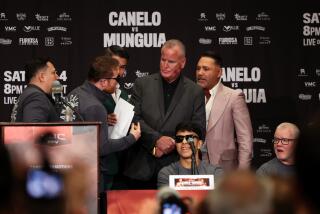Gold Made Them, Breaks Them
- Share via
They seemed a match made in boxing heaven. Bob Arum and Oscar De La Hoya united the master promoter and slick salesman of his sport with the Golden Boy, masterful fighter and slick salesman of everything from commercial products to his cultural heritage.
For nearly eight years, they were an unbeatable team, in and out of the ring.
Coming out of the 1992 Olympics with a gold medal around his neck, De La Hoya was a ready-made superstar, his fast feet, quick hands and smooth boxing style matched by matinee-idol good looks and an outwardly sweet disposition.
But it was Arum who saw the gold mine beneath the gold medal. It was Arum who saw that De La Hoya was coming along just at the right time to ride the rising tide of Latino awareness as that segment of the population grew to record levels in this country. It was Arum who hand-picked opponents for De La Hoya, making sure that even the big names had passed their prime and were largely living off past glory.
Sometimes shamelessly, always aggressively, Arum pushed the Latino button, from the use of mariachi music at news conferences and fights to the stoking of the flames ignited by traditional Mexican and Mexican-American rivalries.
Although the media picked up the “Chicken De La Hoya” label attached by longtime boxing writer Michael Katz, Arum held firm. Big-time money for small-time or past-their-prime opponents was the strategy.
Finally last year, De La Hoya fought Ike Quartey, De La Hoya’s first world-class opponent still at the world-class level. Felix Trinidad and Shane Mosley soon followed.
But by then, the money machine was in high gear. De La Hoya’s ring earnings have surpassed $125 million and he has faced real danger only three times. His fight against Trinidad last September was the richest non-heavyweight bout ever. De La Hoya had become the most prominent non-heavyweight in the history of the sport. His picture was plastered on all sorts of products and beamed from every form of communication, old and new. Women mobbed him as if he were a rock star.
Other fighters moaned and demanded to be paid “Oscar money.”
But there was only one Oscar. And for that, he could largely thank Arum.
De La Hoya made himself a good fighter. Arum made him a great attraction.
But all that seemed forgotten Tuesday, when De La Hoya authorized his lawyers to sue Arum in U.S. District Court in Los Angeles in an attempt to terminate their relationship.
It was as if Pinocchio had fired Geppetto.
With Arum vowing to countersue, it is highly questionable whether the proposed De La Hoya-Mosley rematch will be held on the proposed Jan. 20 date. Cedric Kushner, Mosley’s promoter, will meet with HBO officials Tuesday to discuss the possibility of Mosley’s fighting someone else in December or January while a judge referees the Arum-De La Hoya battle.
Nobody should feel sorry for Arum. He didn’t build up De La Hoya because of an inherent desire to promote a Latino cause. He did it to make his own millions, which he certainly did.
But that ultimately cost him his role as De La Hoya’s promoter.
The relationship between promoter and fighter is almost always uneasy. The fighter needs the promoter to boost his earning power, yet always glances nervously over his shoulder, worried that the promoter is taking too much for himself without investing as much in blood, sweat and tears.
The discord between De La Hoya and Arum first surfaced publicly in a February 1999 Dodger Stadium news conference before De La Hoya’s match against Quartey. De La Hoya, on a Spanish-language television station, had threatened to split with Arum if it was true that the promoter had already agreed to a rematch against Quartey.
But that was only a cover story. What De La Hoya really wanted was a piece of the promotional pie. Arum gave it to him, making De La Hoya a co-promoter for that fight.
“It was a big misinterpretation,” De La Hoya said after getting the financial deal he wanted. “I will be happy to be with Bob Arum for the rest of my career. He’s the reason I’m here.”
But De La Hoya seemed to forget that seven months later, when he learned Arum had made $12 million off the Trinidad fight.
Never mind that De La Hoya had made about $23 million himself. Nor that Arum made that much money only because De La Hoya had decided to take a guarantee rather than the risk of going for a larger percentage of anticipated revenue, a risk that Arum shouldered and turned into a financial bonanza.
But all that said, De La Hoya still questioned why any promoter should take home that much money.
The resentment lingered and festered.
And then, in June, after De La Hoya’s loss to Mosley, the resentment surfaced publicly and in very ugly fashion as De La Hoya, angry and frustrated over the defeat, lashed out in all directions at the postfight news conference.
He even talked incoherently about some mysterious plot that cost him the fight in order to set up a rematch. That seemed to point the finger at his promoter.
In the weeks that followed, Arum publicly suggested that perhaps trainer Robert Alcazar should be replaced.
Alcazar responded by saying that he serves at the pleasure of De La Hoya, not Arum.
The friction heated.
Then, with De La Hoya dragging his feet on a rematch with Mosley while he focused on his budding singing career, Arum said in a Times story that, if De La Hoya’s singing career was a success and if he continued to be ambivalent about boxing, he should retire.
De La Hoya fumed at that remark, but by then he and Arum were already nearing a fork in the road.
De La Hoya was questioning with increasing frequency why he needed to share his wealth with a promoter. He saw fighters such as Prince Naseem Hamed and Roy Jones taking control of their careers.
So De La Hoya decided to do the same.
When De La Hoya beat Julio Cesar Chavez the first time, Joel De La Hoya, Oscar’s father, climbed into the ring, and said to Arum, “Now, we can make some real money.”
The younger De La Hoya’s check for that fight was $9 million.
You can imagine Joel talking to Oscar in the wake of the Arum split and saying it again.
But can the De La Hoyas make it on their own?
Keep in mind that for all his difficulties, Oscar has lost his two fights on a majority decision and a split decision. Many, including this reporter, had him winning the Trinidad fight. It’s not as if he’s being thoroughly dominated in the ring.
If he gets a rematch with Mosley, he’s only one knockout punch away from restoring some of the glitter to his golden image.
If he can beat Mosley, he can prosper without Arum.
But if he loses again to Mosley, even Arum would be hard-pressed to resurrect a De La Hoya who had lost three of his last four fights.
Arum would tell you that he made De La Hoya.
De La Hoya would tell you that he has done the work and he wants all the rewards.
Arum would tell you he was there from the beginning.
De La Hoya would tell you Arum wouldn’t have stayed if De La Hoya hadn’t kept winning.
Should De La Hoya have shown more loyalty to his mentor?
This isn’t about loyalty. It’s about money.
And from the very beginning, from the day De La Hoya struck gold in Barcelona, it always was.
More to Read
Go beyond the scoreboard
Get the latest on L.A.'s teams in the daily Sports Report newsletter.
You may occasionally receive promotional content from the Los Angeles Times.










